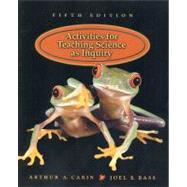Infused with the philosophical intent of the National Science Education Standards, the fifth edition of Activities for Teaching Science as Inquiry includes hands-on and process-oriented activities, and guides teachers to act as facilitators of learning.
Features of the fifth edition include:
- Inclusion of a model lesson to illustrate how to structure scientific inquiry within the framework of a teaching model.
- Practical suggestions for building learning communities.
- Integrated multimedia package:
- For professors: Three free videos from the Annenberg/CPB math and science series. Video Cases illustrate professional practice in science education, model science inquiry in classrooms, and exemplify the ongoing, reflective process teachers engage in to assess the effectiveness of their instruction.
- For students: A free Companion Website presents additional classroom video with corresponding performance assessment activities.









